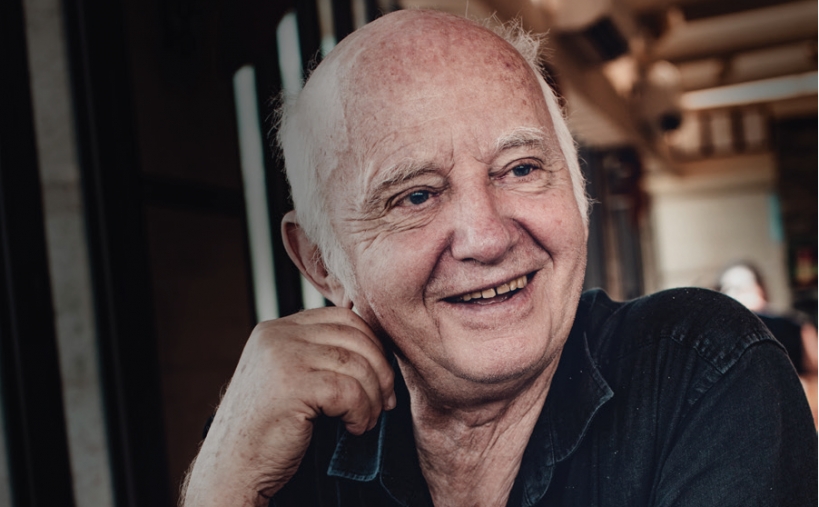
Meet the man credited for bringing the Maldives on the world map of tourist destination during the early 70s, nearly 45 years ago. And since 1976 through his never-ending collection of picture-perfect postcards, posters and books that decorates the shelves of every souvenir shop across the country. Exclusively for The Island Chief, we sat down with Michael in Malé to have an inspiring, reflective, insightful interview.
Did you discover the photography or the photography found you? What was it that captivated you from the beginning? In short, what is photography for you?
I was an 18-year-old student who took many day trips from Germany to Italy when I first began photography. I chose Italy considering its close distance from Germany. Those were the very first photographs of mine and today they are on display at Leica gallery in Frankfurt. I also attained first prize 1954 at Photokina, an annual trade fair held in Cologne, Germany for photographic and imaging professionals.I quickly became a professional freelance photographer photographing also the top Italian movie stars like Sophia Loren and Claudia Cardinale, making them famous. And they are still around and living.
You have witnessed an era when tourism flourished across the Maldives, you have seen hope, change, development. What is the project that has left the most impression on you and your way of photographing it?
Different of my photos became famous and the symbol, the trademark of the Maldives, published worldwide. It was a shot of a graceful coconut palm that reclined by the shores of Kuda Bandos. It was also the most published and stolen and copied photograph of mine. I captured the famous shot in 1976 while my wife comfortably sat over the portion of the half- sunken tree reading a book. At that time, foreign visitors were not permitted to spend the night on the uninhabited islands. The then-President Ibrahim Nasir gave us a permit to stay on Kuda Bandos for few nights. Mr. Ahmed Adam, a good friend also in charge of building the first hotels like Bandos provided us with a Maldivian bed (swing) and a large mosquito net.
What ingredients does a photograph need to become an image that can transmit and communicate with it?
For me, the essence of capturing the beauty of the Maldives through the camera lens was photographing the lush green vegetation, the never-ending silky-smooth sand surrounding the turquoise waters, the perfect round islands. These views are what the Maldives captivates visitors from around the world!
What first inspired you to create the postcards of the Maldives?
It was purely experimental. I never thought it would work out so well. Mr. Kandi Ismail suggested me to try it, so I first created four postcards of Villingili resort during its opening. Mr. Kandi Ismail (later Kaimoo – Embudu – Equator Village – Gan – Summer Island) needed the postcards and posters for marketing the Maldives in name of the government Tourist Agency.
Each person looks at things differently and interacts with them in his particular way within the environment. How do you learn to look at things? How to see a little beyond what is evident?
This is the secret of a professional photographer. Most people take pictures for themselves, but I take pictures for others. I do not shoot photographs that depict problems and violence, because it does not inspire people. I do not think there were 200 photographers around the globe that knew this business in the 70s inspiring people to escape the cold weather in winter.
Photography is undoubtedly a powerful tool of language, what is your opinion on the current photography and how do you see its evolution in the medium term?
Maldivian photographers have come so much better now. They have mastered in capturing the right content to convince potential holiday seekers. During late 70s, many Maldivian photographers would be shooting photos of birds or flowers, but now many of them can shoot incredible wedding photography and make their clients happy. There are some extremely talented Maldivian photographers that I know, and are good at resort photography. There are several factors to consider when doing resort photo shoots, such as time, weather, natural lighting, the right angel, etc.
How was it like capturing aerial shots of the atolls and islands back in the good old days without drones?
It was a daunting task. I hired a four seater – one engine – Cessna from the Sri Lanka Airforce because only from above, from a plane you see the full beauty of the Maldives. Later I used helicopters and seaplanes, seldom a parasail – more dangerous. Once I lost three cameras landing in the open sea.
What are you currently pursuing and what plans do you have on the horizon?
I do not shoot resort photography anymore. Local photographers do a better job and have more time. I am planning to photograph some of the local island communities and their daily life. Once I have been on Kamadhoo/Baa Atoll for a week in the 1980s, a great experience.
What’s your advice for aspiring photographers?
Many people capture good photographs to create postcards, but often fail to sustain and replenish it. By the time, they generate revenue; they do not have funds to reprint it. There is also a great demand for resort photography. It is important to ask a good price even for the first job. If the photographer does a good first job he will get a second job. Working for free is not productive.
“Secret of a professional photographer - Most people take pictures for themselves, but I take pictures for others”
Please login to Comment